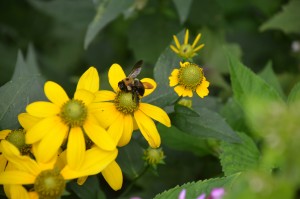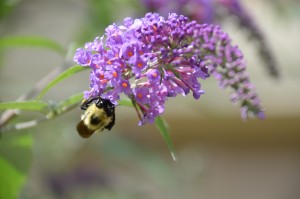Bumble bees (Bombus spp.) are highly beneficial insects that pollinate native wildflowers, fruits, vegetables, and many agricultural crops. They’re large robust insects with an easily identifiable black and yellow hairy abdomen. Hundreds of branched hairs pick up and transfer pollen from flowers. About 50 species of bumble bees inhabit North America.
They share some common traits with honey bees, which are not native. Both are highly social insects and live in colonies with one queen and many workers. Bumble bee colonies last less than one year compared to honey bees. They do not store a surplus of honey for harvested. Populations fluctuate from year to the next, subject to environmental factors, parasites and predators.
Bumble bees are ground nesters, making their colonies in mostly underground holes or a few above ground partly covered by debris. Their nests are larger than those of solitary bees. In early spring a young queen finds an abandoned nest or burrow made by another critter and prepares it for her brood. She builds a few wax pots that she fills up with pollen and honey, and a larger cell for her brood. She lays her eggs, laying no more than half a dozen at first. These eldest offspring are all sterile female workers. Once this brood is fully grown, the queen rarely leaves the nest again and spends all her time laying more eggs while the workers take care of all the activities in and out of the nest.
By midsummer the colony (nest) grows rapidly and will have 20-100 workers. Near summer’s end, the queen lays eggs containing fertile males and females. The females emerge from the nest and mate with males. All sterile workers, male bumble bees, and queen mother die at the end of summer. A mated queen hibernates 2-5 inches deep in the soil over winter and re-emerges found a new nest.
In some countries bumble bees are imported to pollinate specific crops such as forage clover (Trifolium pratense) in fields and tomato crops in greenhouses. They can fly at much lower temperatures than honeybees and can pollinate flowers with long, narrow corollas.
Source: several USDA publications on Bumble bees



 Posted in
Posted in 
